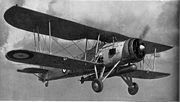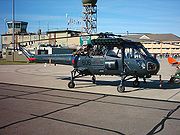
705 Naval Air Squadron
Encyclopedia
705 Naval Air Squadron was first formed in 1936 from No 447 Flight Royal Air Force and operated Swordfish torpedo bombers from battlecruisers. It was disbanded in 1940, but was re-formed in 1947 as a Fleet Requirements Unit to evaluate naval use of helicopters. Since the 1950s the squadron has been involved in the basic training of helicopter aircrew, and currently forms part of the Defence Helicopter Flying School at RAF Shawbury.
 705 Naval Air Squadron (or "705 NAS") was formed from No 447 Flight Royal Air Force
705 Naval Air Squadron (or "705 NAS") was formed from No 447 Flight Royal Air Force
, standing up in June 1936. Operational control of naval aviation was returned to the Royal Navy
on 30 July 1937, and during this period the squadron operated the Fairey Swordfish
biplane torpedo bomber from the battlecruisers Repulse
and Renown
. The aircraft were equipped with floats so that they could be launched from the ships by catapult and then recovered from the water by crane. Early in World War II the squadron saw service protecting troop convoys and hunting raiders on the North America and West Indies Station. After disembarkation to RNAS Lee-on-Solent in 1939, the squadron was disbanded in 1940.
element from 771 NAS. At first the squadron operated as a Fleet Requirements Unit, and was responsible for the evaluation of the helicopter for use at sea. On 1 February 1947 Lieutenant K Reed carried out the first helicopter deck landing on a Royal Naval ship when he landed on HMS Vanguard
off Portland
.
_bw.jpg) The squadron gradually became responsible for the basic flying training of Royal Naval helicopter pilots and was re-equipped during the 1950s with the Westland Dragonfly
The squadron gradually became responsible for the basic flying training of Royal Naval helicopter pilots and was re-equipped during the 1950s with the Westland Dragonfly
, the Hiller HT1 and the Sikorsky S55. The squadron moved to RNAS Culdrose
in 1957 where the later marks of Hiller and Whirlwind were introduced. These types were replaced in 1974 by the Westland Gazelle HT Mk2
. Between 1975 and 1992 the instructors of the squadron performed as the 'Sharks' helicopter display team
at up to 20 air displays every year both in the UK and abroad.
in Shropshire as part of the Defence Helicopter Flying School
(DHFS), flying the Eurocopter Squirrel HT Mk 1 helicopter.
In addition to pure flying training, 705 Squadron also provides a naval focus for naval officers operating within an otherwise joint service and largely civilian-run organisation. The squadron is commanded by a Royal Navy Lieutenant Commander
, and has a Royal Navy "Senior Pilot", while the flight commander billets are filled in rotation by officers from the army and RAF. Naval graduates of DHFS are streamed towards Merlin, Commando Sea King
or Lynx
training squadrons.

Pre-war and World War II (1936 - 1940)

Royal Air Force
The Royal Air Force is the aerial warfare service branch of the British Armed Forces. Formed on 1 April 1918, it is the oldest independent air force in the world...
, standing up in June 1936. Operational control of naval aviation was returned to the Royal Navy
Royal Navy
The Royal Navy is the naval warfare service branch of the British Armed Forces. Founded in the 16th century, it is the oldest service branch and is known as the Senior Service...
on 30 July 1937, and during this period the squadron operated the Fairey Swordfish
Fairey Swordfish
The Fairey Swordfish was a torpedo bomber built by the Fairey Aviation Company and used by the Fleet Air Arm of the Royal Navy during the Second World War...
biplane torpedo bomber from the battlecruisers Repulse
HMS Repulse (1916)
HMS Repulse was a Renown-class battlecruiser of the Royal Navy built during the First World War. She was originally laid down as an improved version of the s. Her construction was suspended on the outbreak of war on the grounds she would not be ready in a timely manner...
and Renown
HMS Renown (1916)
HMS Renown was the lead ship of her class of battlecruisers of the Royal Navy built during the First World War. She was originally laid down as an improved version of the s. Her construction was suspended on the outbreak of war on the grounds she would not be ready in a timely manner...
. The aircraft were equipped with floats so that they could be launched from the ships by catapult and then recovered from the water by crane. Early in World War II the squadron saw service protecting troop convoys and hunting raiders on the North America and West Indies Station. After disembarkation to RNAS Lee-on-Solent in 1939, the squadron was disbanded in 1940.
Fleet Requirements Unit (1947 - 1950)
In May 1947, 705 Squadron was re-commissioned at RNAS Gosport with the Sikorsky HoverflySikorsky R-4
The Sikorsky R-4 was a two-place helicopter designed by Igor Sikorsky with a single, three-bladed main rotor and powered by a radial engine. The R-4 was the world's first large-scale mass-produced helicopter and the first helicopter to enter service with the United States Army Air Forces, Navy, and...
element from 771 NAS. At first the squadron operated as a Fleet Requirements Unit, and was responsible for the evaluation of the helicopter for use at sea. On 1 February 1947 Lieutenant K Reed carried out the first helicopter deck landing on a Royal Naval ship when he landed on HMS Vanguard
HMS Vanguard (23)
HMS Vanguard was a British fast battleship built during World War II and commissioned after the end of the war. She was the only ship of her class and was the biggest, fastest and last of the Royal Navy's dreadnoughts, and the final battleship to be launched in the world...
off Portland
Isle of Portland
The Isle of Portland is a limestone tied island, long by wide, in the English Channel. Portland is south of the resort of Weymouth, forming the southernmost point of the county of Dorset, England. A tombolo over which runs the A354 road connects it to Chesil Beach and the mainland. Portland and...
.
Helicopter flying training (1950 - 1997)
_bw.jpg)
Westland Dragonfly
|-See also:-External links:* Westland entry in the helis.com database*...
, the Hiller HT1 and the Sikorsky S55. The squadron moved to RNAS Culdrose
RNAS Culdrose
Royal Naval Air Station Culdrose , based in Cornwall, near Helston, on the Lizard Peninsula, has three major roles: serving the Fleet Air Arm's front line Sea King and Merlin helicopter squadrons; providing search and rescue for the South West region; and training specialists for the Royal Navy...
in 1957 where the later marks of Hiller and Whirlwind were introduced. These types were replaced in 1974 by the Westland Gazelle HT Mk2
Aérospatiale Gazelle
The Aérospatiale Gazelle is a five-seat light helicopter, powered by a single turbine engine. It was designed and manufactured in France by Sud Aviation . It was also manufactured under licence by Westland Aircraft in the United Kingdom , by SOKO in Yugoslavia and ABHCO in Egypt...
. Between 1975 and 1992 the instructors of the squadron performed as the 'Sharks' helicopter display team
The Sharks (Royal Navy)
The "Sharks" were the Royal Navy's Helicopter Display Team from 1975 to 1992. They flew four red Aérospatiale Gazelle helicopters, with aircraft and pilots drawn from 705 Naval Air Squadron based at RNAS Culdrose, Cornwall.-History:...
at up to 20 air displays every year both in the UK and abroad.
Tri-service basic flying training (1997 - present)
In April 1997 705 NAS disbanded and reformed at RAF ShawburyRAF Shawbury
RAF Shawbury is a Royal Air Force station by the village of Shawbury near Shrewsbury, Shropshire.The station at Shawbury was first used for military flying training in 1917 by the Royal Flying Corps, but it was returned to agricultural use in 1920. In 1938 it was reactivated as a training...
in Shropshire as part of the Defence Helicopter Flying School
Defence Helicopter Flying School
The Defence Helicopter Flying School at RAF Shawbury, a Royal Air Force station near Shrewsbury, England, trains aircrew from all three of the Armed Forces.-Squadrons:The DHFS has three flying squadrons:...
(DHFS), flying the Eurocopter Squirrel HT Mk 1 helicopter.
Current Role
Within DHFS, 705 Squadron provides the single-engine advanced training element of basic helicopter flying training for all three services, as well as pilots from foreign and Commonwealth countries. Within this remit, 705 Squadron teaches instrument flying, navigation, night flying and search and rescue techniques.In addition to pure flying training, 705 Squadron also provides a naval focus for naval officers operating within an otherwise joint service and largely civilian-run organisation. The squadron is commanded by a Royal Navy Lieutenant Commander
Lieutenant Commander
Lieutenant Commander is a commissioned officer rank in many navies. The rank is superior to a lieutenant and subordinate to a commander...
, and has a Royal Navy "Senior Pilot", while the flight commander billets are filled in rotation by officers from the army and RAF. Naval graduates of DHFS are streamed towards Merlin, Commando Sea King
Westland Sea King
The Westland WS-61 Sea King is a British licence-built version of the American Sikorsky S-61 helicopter of the same name, built by Westland Helicopters. The aircraft differs considerably from the American version, with Rolls-Royce Gnome engines , British made anti-submarine warfare systems and a...
or Lynx
Westland Lynx
The Westland Lynx is a British multi-purpose military helicopter designed and built by Westland Helicopters at its factory in Yeovil. Originally intended as a utility craft for both civil and naval usage, military interest led to the development of both battlefield and naval variants...
training squadrons.
Aircraft flown
The squadron has flown a number of aircraft types since its formation, including:- Blackburn Shark II/SPBlackburn Shark-Bibliography:* Mason, Francis K. The British Bomber since 1914. London: Putnam Aeronautical Books, 1994. ISBN 0-85177-861-5.* Shores, Christopher, Brian Cull and Yasuho Izawa. Bloody Shambles:Volume One:The Drift to War to the Fall of Singapore. London:Grub Street, 1992. ISBN 0-948817-50-X.*...
- Fairey Swordfish I/SP & IIIFairey SwordfishThe Fairey Swordfish was a torpedo bomber built by the Fairey Aviation Company and used by the Fleet Air Arm of the Royal Navy during the Second World War...
- Sikorsky Hoverfly I & IISikorsky R-4The Sikorsky R-4 was a two-place helicopter designed by Igor Sikorsky with a single, three-bladed main rotor and powered by a radial engine. The R-4 was the world's first large-scale mass-produced helicopter and the first helicopter to enter service with the United States Army Air Forces, Navy, and...
- Saunders-Roe Skeeter
- Westland Dragonfly HR1, HR3 & HR5Westland Dragonfly|-See also:-External links:* Westland entry in the helis.com database*...
- Hiller HT1 & HT2
- Sikorsky S55
- Westland Whirlwind HAS22, HAR1, HAR3 & HAS7Westland WhirlwindWestland Whirlwind may mean:* Westland Whirlwind , a fixed wing Second World War fighter aircraft* Westland Whirlwind , a post-war helicopter based on the Sikorsky S-55...
- Westland Wasp HAS1Westland WaspThe Westland Wasp was a British small first-generation, gas-turbine powered, shipboard anti-submarine helicopter. Produced by Westland Helicopters, it came from the same P.531 programme as the British Army Westland Scout, and was based on the earlier piston-engined Saunders-Roe Skeeter...
- Westland Gazelle HT2Aérospatiale GazelleThe Aérospatiale Gazelle is a five-seat light helicopter, powered by a single turbine engine. It was designed and manufactured in France by Sud Aviation . It was also manufactured under licence by Westland Aircraft in the United Kingdom , by SOKO in Yugoslavia and ABHCO in Egypt...
- Eurocopter Squirrel


